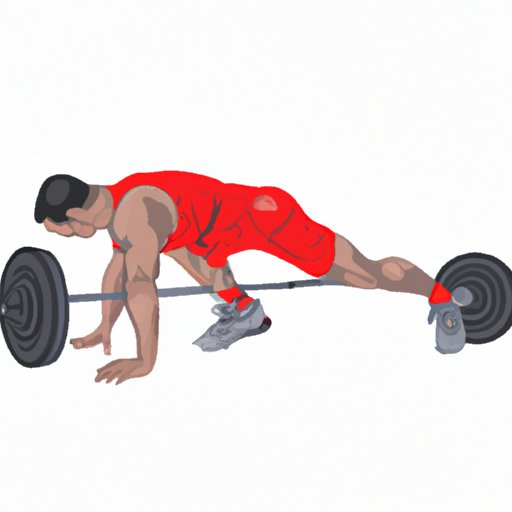
Introduction
For people who exercise regularly, you may be familiar with that burning sensation you feel in your muscles during a tough workout. That sensation is caused by lactic acid, a substance produced by the body during physical activity. While a small amount of lactic acid is normal and can even be beneficial for some athletes, too much lactic acid build-up can result in fatigue, soreness, and hinder performance. In this article, we will explore different techniques and methods that can help you get rid of lactic acid, so you can feel better and perform better in your workouts.
Understanding the Science of Lactic Acid and How to Combat its Effects
Before we dive into different techniques to combat lactic acid build-up, let’s understand the basics of lactic acid production in the body during exercise. During intense exercise, the body may not be able to supply enough oxygen to meet the demand of muscle cells. As a result, the cells switch to an alternative energy pathway that produces lactic acid as a by-product. This build-up of lactic acid can cause muscle fatigue, soreness, and decreased performance.
The effects of lactic acid build-up on muscles vary depending on the individual’s fitness level, intensity of exercise, and other factors. Some athletes may experience the “burn” associated with lactic acid build-up during highly intense exercises, while others may experience it during less intense exercises. To combat the effects of lactic acid in the body, there are a few different techniques that can be used.
5 Simple Exercises to Help Flush Lactic Acid from Your Muscles
One effective ways to reduce lactic acid build-up is through specific exercises. Here are 5 simple exercises that can help:
- Walking: A low-impact exercise like walking can increase blood flow and oxygen to the muscles, helping to flush out lactic acid. A brisk walk for 20-30 minutes after a workout can be beneficial.
- Yoga: Yoga can help relax tense muscles and increase blood flow. Some poses, such as child’s pose or downward-facing dog, can target specific muscle groups and help reduce lactic acid build-up.
- Cycling: Cycling can help promote blood flow and oxygenation, which reduces lactic acid build-up and helps with recovery.
- Swimming: Swimming is a low-impact exercise that can help increase blood flow and reduce muscle soreness.
- Pilates: Pilates can help lengthen and strengthen muscles and improve blood flow, leading to faster recovery and reduced lactic acid build-up.
Effective Breathing Techniques to Reduce Lactic Acid Build-Up During Workouts
Breathing is an important component of exercise that can affect lactic acid build-up. During exercise, proper breathing can help increase oxygen delivery to muscles and reduce lactic acid build-up.
Two effective breathing techniques are:
- Deep Breathing: Take deep breaths in through your nose and out through your mouth during exercise. This can help increase oxygen delivery to your muscles, leading to less lactic acid build-up.
- Exhale on Exertion: Exhale during the most difficult part of an exercise (e.g. when lifting weights). This helps to manage lactic acid build-up and make the exercise feel less exhausting.
How to Effectively Stretch Before, During, and After Your Workout to Reduce Lactic Acid
Stretching is an important part of reducing lactic acid build-up. Here are some guidelines to follow for effective stretching:
- Warm-up: Start by doing 5-10 minutes of light cardio to warm up your muscles before stretching.
- Stretching before exercise: Stretching before exercise can help improve flexibility and reduce muscle soreness after exercise. Hold each stretch for 30 seconds and breathe deeply.
- Stretching during exercise: Stretching during exercise can help reduce lactic acid build-up and improve performance. Incorporate dynamic stretches that involve movement.
- Stretching after exercise: Stretching after exercise can help reduce muscle soreness and stiffness. Spend more time stretching after a workout, holding each stretch for up to 60 seconds.
The Top Foods to Incorporate into Your Diet to Reduce Lactic Acid Build-Up
Nutrition also plays a role in reducing lactic acid build-up. Here are some foods to incorporate into your diet:
- Complex carbohydrates: Foods like sweet potatoes, quinoa, and brown rice provide sustained energy and can help reduce lactic acid build-up.
- Protein: Eating foods high in protein can help repair and rebuild muscle tissue, which can reduce lactic acid build-up. Choose lean protein sources like chicken, fish, and tofu.
- Antioxidant-rich foods: Antioxidants can help reduce inflammation and promote healing in sore muscles. Berries, leafy green vegetables, and nuts are all good sources of antioxidants.
- Healthy fats: Foods like avocados, nuts, and olive oil can help reduce inflammation and provide sustained energy during exercise.
- Hydration: Drinking enough water is essential for proper muscle function and preventing lactic acid build-up. Aim to drink at least 8 glasses of water per day.
The Benefits of Massage Therapy in Reducing Lactic Acid Build-Up in Muscles
Massage therapy can also help reduce lactic acid build-up. Here are some types of massage that may be beneficial:
- Deep Tissue Massage: This type of massage uses deep pressure to break up knots and tension in the muscles, which can help reduce lactic acid build-up.
- Sports Massage: Sports massage is designed specifically for athletes and can help improve performance and reduce muscle soreness.
- Trigger Point Massage: Trigger point massage targets specific areas of tension in the muscles, which can help release lactic acid build-up and improve muscle function.
Conclusion
In conclusion, lactic acid build-up can hinder performance and lead to increased muscle soreness and fatigue. However, there are many techniques and methods to help combat lactic acid build-up, from specific exercises and breathing techniques to proper stretching, nutrition, and even massage therapy. By incorporating these methods into your workout routine, you can experience better performance and recovery in your exercise regimen.





